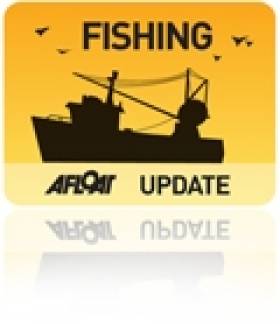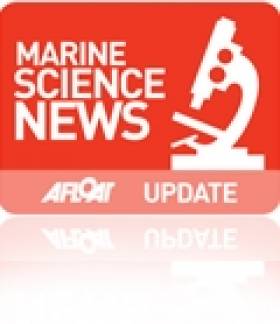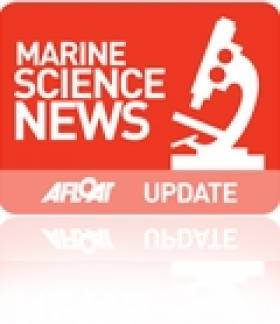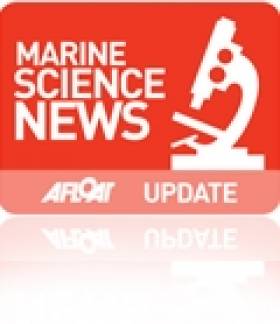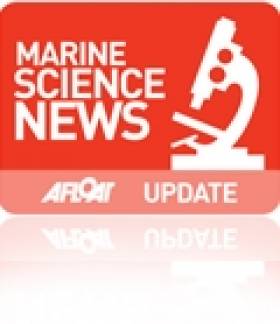Displaying items by tag: marine science
Unfishable Areas May Be Refuge for Endangered Flapper Skate
#FISHING - Marine scientists working in the Celtic Sea have discovered a natural refuge for the critically endangered flapper skate.
Many elasmobranchs (sharks, rays and skates) are highly vulnerable to over-fishing, but a new paper in the open access journal PLOS ONE shows that small areas of the seabed that experience below-average fishing intensity can sustain greater populations of these species.
The study reveals that one remarkable area in the northeastern Celtic Sea - where uneven seabed makes trawling difficult - supports at least ten species of elasmobranch, including the rare blue skate (Dipturus flossada) and related flapper skate (Dipturus intermedia).
Dipturus was previously considered to represent a single species (D. batis), but made the news in 2009 when a case of misidentification was revealed.
Both species are now listed as critically endangered but populations of the flapper skate, which can grow up to 2.5 metres in length, are considered to be under greatest threat from extinction.
European Union regulations mandate that fishermen throw back any flapper skate but its slow growth and reproduction mean that even very low levels of fishing mortality are now unsustainable for this species.
Scientists from Queen’s University Belfast, Bangor University and the Marine Institute carried out the study. Lead researcher Dr Samuel Shephard suggests that “the discovery of a Celtic Sea stronghold for flapper skate provides a remarkable opportunity to help save a species on the verge of extinction”.
Professor Michel Kaiser, chair in marine conservation at Bangor University, added: “Some have previously argued that areas of little interest to the fishing industry are not worthy of conservation, however this study clearly overturns that perception and highlights just how important some of these areas are."
Importantly, the fishing industry has reacted positively to the ‘win-win’ situation that an area of little commercial interest has potential as an important marine reserve.
Professor Dave Reid of the Marine Institute presented the information to industry leaders, and this has led to the inclusion of the area in proposed management plans for elasmobranchs in the Irish and Celtic Seas.
Eibhlín O’Sullivan, CEO of the Irish South & West Fishermen’s Organisation, responded that the Irish fishing industry "has been working with the Marine Institute for the past 18 months on developing a management plan for skates and rays. This new research adds valuable information for the identification of potential seasonally closed areas."
Prof Reid noted that “this is a great model for collaboration on conservation between the fishing industry and scientists”.
The research leading to these results has received funding from the European Community's Seventh Framework Programme (FP7/2007-2013).
Irish Marine Science Chief Appointed to European Research Board
#marinescience – Dr. Peter Heffernan, CEO Marine Institute, has been appointed to the European Research and Innovation Area Board (ERIAB) by European Commissioner for Research, Innovation and Science Máire Geoghegan-Quinn. The 11 member board advises the Commissioner on issues relating to the development of the European Research Area, including the €80 billion Horizon 2020 Programme for Research and Innovation (2014-2020). Members of the ERIAB are appointed for a four year term and the mandate of current ERIAB extends to February 2016.
"I look forward to working with Dr. Peter Heffernan as a member of the European Research and Innovation Area Board, ERIAB," said Commissioner Geoghegan-Quinn. "In the coming years, ERIAB will play a vital role in the development and optimisation of the European Research Area. Members of ERIAB are highly respected scientific and policy advisors who will draw on their extensive experience at national and international level, and I am delighted to have an Irish member of Peter's calibre on board".
The Taoiseach Mr Enda Kenny, TD said the appointment represented an important recognition not only of Dr Heffernan's own contribution but also of the work of the Marine Institute over the years. "Ireland and Europe share many objectives in supporting sustainable ocean economic activities as an important engine of growth in our recovery. I have no doubt that Peter's contribution to ERIAB will be very beneficial in this regard".
Welcoming the announcement, Minister for Jobs, Enterprise and Innovation, Mr Richard Bruton, TD, congratulated Dr Heffernan on his appointment which he said not only reflected Dr Heffernan's standing in the European research community, but also that of Irish science, technology and innovation.
Minister for Agriculture, Food and the Marine, Mr Simon Coveney, TD, joined in congratulating Dr Heffernan, and noted that this appointment also acknowledged the importance of marine science, technology and innovation for the European Research Area, a topic Dr Heffernan has championed both in Ireland and in Europe.
The ERIAB plays a key role in developing, promoting and evaluating EU research, development and innovation policy initiatives and actions, including the further development of the European Research Area (ERA), the implementation of the proposed €80 billion Horizon 2020 Programme (2014-2020) and the Europe 2020 and Innovation Union Strategies. Europe 2020 is a 10-year strategy aimed at reviving the economy of the European Union through "smart, sustainable, inclusive growth, with high levels of employment and living standards".
In July 2012, the Irish Government, through the interdepartmental Marine Co-ordination Group, launched Harnessing Our Ocean Wealth – An Integrated Marine Plan for Ireland, setting out a roadmap to harness the potential of Ireland's marine resource. This plan, part of the marine sectors contribution to the Europe 2020 Strategy, will contribute to the development of the Action Plan of the European Union Strategy for the Atlantic (EUSA) which will have a major bearing and influence on the topics to be supported by EU Structural, Regional, Research and Environment Funds between 2014 and 2020.
Galway Marine Scientist is New President of International Council for Exploration of the Sea
#marinescience – The International Council for the Exploration of the Sea (ICES) has elected Dr Paul Connolly as its new President for a three-year term (Nov 2012 – Oct 2015). Dr. Connolly is the Director of Fisheries Ecosystems Advisory Services at the Marine Institute.
Commenting on his election Dr Connolly said "This is a great honour and comes at a time of great opportunities for ICES. The ocean affects every human life and a growing public awareness of the use of the ocean is driving a demand for impartial marine science and advice".
Marine Institute CEO, Dr. Peter Heffernan welcomed the appointment. "It's a testament to Dr Connolly's dedication to excellence in marine science, his long standing commitment to ICES, and the key the role of Irish and international scientists in understanding marine ecosystems."
Minister Simon Coveney T.D also congratulated Dr Connolly on this prestigious appointment. The Minister said "this is a great honour for Paul and is well deserved. The appointment recognises his huge contribution to the world of marine science and underlines the high esteem that both he and his colleagues in the Marine Institute are held in the international scientific community."
ICES coordinates and promotes marine research on oceanography, the marine environment, the marine ecosystem, and on living marine resources in the North Atlantic. It is the prime source of scientific advice on the marine ecosystem to governments and international regulatory bodies that manage the North Atlantic Ocean and adjacent seas. ICES maintains some of the world's largest databases on marine fisheries, oceanography, and the marine environment, and its Data Centre is part of a global network of data centres.
"Against a changing policy landscape and a challenging economic climate, a key job in the coming year will be the renewal of the ICES Strategic Plan for the period 2014 to 2018. Getting our strategy right will be critical," said Dr Connolly.
ICES is a network of more than 1600 scientists from 200 institutes linked by an intergovernmental agreement (the ICES Convention) to add value to national research efforts.
Ireland has a long association with ICES. Founded in Copenhagen, Denmark in 1902 it is one of the oldest intergovernmental organisations. Ireland joined ICES in 1924 and two of its 29 presidents have been Irish - Arthur Went (1966 to 1969) and David Griffith (1991 to 1994). "A key focus of the job will be to ensure that the ICES scientific community remains relevant, responsive, sound, and credible, concerning marine ecosystems and their relation to humanity," said Dr Connolly.
Irish Marine Scientists Discover 'Smoking Vents' on Mid-Atlantic Ridge
#UCC – Irish research which led to the discovery of smoking vents on the mid Atlantic Ridge will feature in a National Geographic programme to be broadcast next Sunday, 28 October.
National Geographic has produced a five part series, The Alien Deep, which takes viewers into underwater worlds where no human has gone before.
The programme will be broadcast this Sunday 28th October at 6pm on National Geographic channel on Sky (channel 526) and also UPC (channel 215). The programme presenter is Dr Robert Ballard, famed explorer who found the Titanic at its final resting place.
The series takes viewers into an underwater world 3,000m deep, where, on the slopes of the Mid-Ocean ridges that divide the earth's tectonic plates, chimney- like formations spew black plumes of superheated water packed with chemicals, minerals and dissolved gases allowing life to thrive against the odds. The leader of the scientific team was Dr Andy Wheeler, School of Biological, Earth and Environmental Sciences at University College Cork who worked with scientists from the National University of Ireland Galway, Geological Survey of Ireland, the University of Southampton and the National Oceanography Centre in the UK. "It's great to see Ireland's expertise recognised on TV", says Dr Wheeler. "Discovering a new volcanic landscape three km below was a thrill."
The scientists were on board the Irish National Research Vessel, Celtic Explorer and used the Remotely Operated Vehicle Holland 1 for their explorations of the deep and was supported by the Marine Institute under the 2011 Ship-Time Programme of the National Development Plan.
The team named the previously uncharted field of hydrothermal vents along the Mid-Atlantic Ridge, the first to be explored north of the Azores, the Moytirra Vent Field. Moytirra is the name of a battlefield in Irish mythology, and appropriately means 'Plain of the Pillars'. Patrick Collins from the Ryan Institute, NUI Galway led Ireland's marine biological team on the surve
Rare Finds in 25th Anniversary Coastwatch Survey
#COASTAL NOTES - The remains of a leatherback turtle were among the finds reported by 'citizen scientists' taking part in the Coastwatch survey of Ireland's coastline, according to The Irish Times.
As previously reported on Afloat.ie, the 'eco audit' marked the 25th anniversary of the first nationwide Coastwatch survey, taking in use of land and shore, quality of inflow water, waste and pollution, and selected coastal and marine wildlife and plantlife.
The survey period concluded at the weekend with an event at the new Tralee Bay Wetlands centre attended by Minister for Heritage Jimmy Deenihan, close to one of the rare discoveries by survey volunteers in the shape of honeycomb worm reefs.
The Irish Times has more on the story HERE.
#Minister for Natural Resources Fergus O'Dowd will re-launch the Inland Fisheries Ireland vessel, the Cosantóir Bradán, in her new role as a marine survey vessel tonight at 9pm at the Custom House in the Port of Cork.
The vessel, a state asset, is being reassigned in line with changing requirements in areas where the Department of Communications Energy and Natural Resources has responsibility.
The Cosantóir Bradán will now be employed as part of INFOMAR, the national marine mapping programme, being conducted by the Geological Survey and Marine Institute and funded by the Department.
The INFOMAR Annual Conference "Enabling our Ocean Management" takes place at University College Cork (UCC)
on Thursday and Friday October 11-12th.
#marinescience – At a leading marine research conference in Cork today, Minister for Natural Resources, Fergus O'Dowd, will re-launch the Inland Fisheries Ireland vessel, the Cosantóir Bradán, in her new role as a marine survey vessel. The Cosantóir Bradán will now be employed as part of INFOMAR, the national marine mapping programme, being conducted by the Geological Survey and Marine Institute and funded by the Department of Communications, Energy and Natural Resources.
The INFOMAR Annual Conference "Enabling our Ocean Management" takes place at University College Cork (UCC) on Thursday and Friday October 11-12th. In addition to the vessel commissioning, the two day seminar includes a range of talks across areas such as ocean energy, hydrography and survey operations, aquaculture and fisheries, applied research, environment and heritage. A full programme of talks is available at www.infomar.ie.
According to the Minister, "I am particularly pleased to be able to attend the INFOMAR 2012 seminar to carry out the re-launch of the Cosantóir Bradán, which showcases the re-use and resultant cost saving made through the re-assignment of a state asset, in line with the changing requirements in areas where the department has responsibility. The Cosantóir Bradán, will now become part of providing the baseline mapping infrastructure in Irish nearshore waters, upon which future fisheries and government marine policy decisions will rely."
Ciaran Byrne, CEO of IFI pointed out, "The Cosantóir Bradán is now available for redeployment due to the changing requirements for the protections of our inshore salmon fisheries. As a result of the cessation of drift net fishing at sea operations have switched to the use of faster inshore vessels which are more focused towards policing the fishery. We are delighted to be able to facilitate the INFOMAR mapping programme, particularly as recipients and users of the updated maps being produced"
The INFOMAR Conference marks the end of a busy survey season for the INFOMAR programme with survey data acquired from all four of Ireland's coastlines including; Dundalk Bay, Co. Louth (with the InterReg IVA INIS HYDRO Project), Bunmahon, Co. Waterford, Inish Bofin and Inish Turk, Co. Galway (with BIM) and Burtonport, Co. Donegal, (with Underwater Archaeology Unit at DoEHLG) and offshore, mapping with the Marine Institute's Celtic Voyager in the Celtic Sea as well as completing the Priority Irish Sea area.
Nutramara Researcher (NUI Galway) Receives Egon Stahl-Award 2012
#NutraMara – Dr. Ulrike Grienke, a postdoctoral researcher based at NUI Galway and a participant in the Teagasc led NutraMara functional foods research programme recently received the prestigious Egon Stahl-Award at a ceremony held in New York. This biennial prize is awarded by the Society for Medicinal Plant and Natural Product Research to an outstanding young scientist.
Dr. Grienke was presented with the award by Prof. Dr. Wolfgang Blaschek, the president of the General Assembly of the Society, during the International Congress on Natural Products Research (July 28th – August 1st, 2012), the largest natural product research meeting ever held in the United States, attended by 1,200 participants. After the award ceremony, Dr. Grienke gave a lecture on the scientific work accomplished during her PhD studies under the supervison of Prof. Judith M. Rollinger at the University of Innsbruck, Austria, which she completed in 2011.
Donated by Professor Egon Stahl (1924-1986) the award is given to young scholars to acknowledge the outstanding quality of their PhD thesis in the field of natural products, and to promote their early career. Prof. Stahl is one of the founders of modern phytochemistry and his work on thin layer chromatography (TLC) remains of fundamental importance.
Dr Grienke joined Professor Deniz Tasdemir's research group at NUI Galway in December, 2011 and works on the isolation of bioactioves from shellfish as part of the NutraMara programme.
NutraMara is funded by the Department of Agriculture Food and Marine, and the Marine Institute and is led by the Teagasc National Food Research Centre. The programme aims to mine marine resources including seaweeds, aquaculture, microalgae and marine processing by-products for functional food ingredients.
Irish Firm Leads Satellite Coastal Research Project
#MARINE SCIENCE - An Irish marine science company will lead a new research project using satellites to monitor coastal outlets in Europe, as Silicon Republic reports.
TechWorks Marine, based in Dun Laoghaire, has won the contract to head up the European Space Agency's earth observation project in what is a first for any Irish company.
The business specialises in real-time marine data platforms, and in this project will be using its expertise to assist operators and developers of water treatment plants to help reduce their impact on the environment.
A main focus of the observation research will be the coastal effect of wastewater treatment in Donegal Bay.
TechWorks Marine MD Charlotte O'Kelly told Silicon Republic that improvements in sensor technology have prompted the development of satellite imagery of a high enough resolution to allow for close monitoring of coastal activity even from earth orbit.
Minister of State for Research and Innovation Sean Sherlock said the contract "clearly indicates that Irish SMEs have the capability and expertise to lead projects in this highly competitive sector".
Silicon Republic has much more on the story HERE.
Galway Showcases Marine Science on 'Sea2Sky' Research Night
#marinescience – Galway will celebrate European Researchers' Night on Friday 28th September together with 320 cities around Europe. The Sea2Sky event organised by NUI Galway in collaboration with the Marine Institute, Galway Atlantaquaria and its new partner CIT Blackrock Castle Observatory in Cork, will showcase science on the grandest of scales themed around marine science, atmospherics and astronomy.
The main events will be held at the Galway Bay Hotel, Leisureland and Galway Atlantaquaria, with events also taking place in CIT Blackrock Castle Observatory in Cork. Máire Geoghegan-Quinn, European Commissioner for Research, Innovation and Science, will officially open the Irish segment of European Researchers Night at 3pm to coincide with events starting right across Europe.
A variety of interactive stands at Galway Bay Hotel will highlight the work of the Marine Institute showing how Ireland's has a rich and diverse marine ecosystem.
"The Sea2Sky event provides a great opportunity for the wider community to engage with scientists and researchers at a local level in Galway and learn about Ireland's marine resource which is ten times the size of its land mass," said Dr Peter Heffernan, CEO of the Marine Institute.
"As a key step in developing our marine sectors including marine technology, seafood, marine biodiscovery, as well as marine tourism, shipping and oil & gas, it is important at events such as this to help encourage the young people of Galway to consider careers in marine research and science now and in the future," he said.
Celebrating marine science and research the Marine Institute will greet visitors with some of Ireland's most impressive marine science, technology and equipment:
The Marine Institute will be showcasing:
The ROV Holland 1 and a Weather Buoy, which will be on display at the entrance to the main exhibit centre at Galway Bay Hotel. Scientists and technicians will be there to explain the work of the equipment and recent expeditions.
Inside the exhibit area, Marine Institute scientists will be exhibiting their work relating to:
Marine Environment: The phytoplankton team will be highlighting what life is in the drop of seawater - promoting the Marine Institute's responsibility in monitoring algal blooms and highlighting their work in the national shellfish food safety programmes. Visitors to the event will get the opportunity to see take the living "invisible" phytoplankton from a rock pool and look at it under a microscope.
Weather Monitoring and Oceanography: Scientists will show a variety of technology used for providing vital data for weather forecasts, shipping bulletins, gale and swell warnings – some of which have recorded Ireland's largest waves at sea.
Advanced Mapping & the Real Map of Ireland: The advanced mapping team will be show casing INFOMAR and seabed mapping and the extent of Ireland's 220 million acre marine resource along with learning about shipwrecks in the deep sea.
Research Vessel's Operations: The RVops team will be displaying the work of the national research vessels RV Celtic Explorer and the RV Celtic Voyager, as well as the remotely operated vehicle ROV Holland 1 and the special equipment used in different expeditions.
VENTuRE scientific expedition / Biodiscovery and Ecosystem Survey of the Whittard Canyons: A short film will be running throughout the day at the Marine Institute stand, showing the newly discovered and previously uncharted field of hydrothermal vents along the Mid-Atlantic Ridge taken by the ROV Holland 1 last year. Amazing footage of the cold water corals and life under the sea at depths of 3000m taken during the Biodiscovery and Ecosystem Survey of the Whittard Canyons will also be shown.
Explorers Education Programme: The Explorers education officer and her team from Galway Atlantaquaria will also be providing demonstrations to children and school teachers highlighting how the seashore is a vital teaching resource and Through experiments and a variety of demonstrations children will be able to look at life in a rock pool in the Explorers display tank - the Nobby boat.
"Irish researchers are involved in some huge European research projects, and this is an opportunity to share some of the most exciting elements with the public. At third-level, we have seen a surge in applications for science related courses and this event will be a real draw for anyone tempted by a career in science and research," said NUI Galway's Dr Andy Shearer, lecturer in physics and organiser of the event.
Last year, some 10,000 people came to the event, and the plan is for an even bigger event this year, with highlights including the CERN exhibit, 3D tours of the universe and tours of the aquarium. This year visitors can participate in experiments, competitions and quizzes, watch demonstrations and simulations, exchange ideas and get to know the researchers at the free family fun event.
This year, Sea2Sky is linking up with the Galway Science Forum's exhibition about the work of CERN – Accelerating Science. This exhibition, sponsored by Boston Scientific in partnership with NUI Galway, will show how CERN's Large Hadron Collider can help us understand fundamental questions about the origins of the universe.
For further details of the event visit www.sea2sky.ie.


























